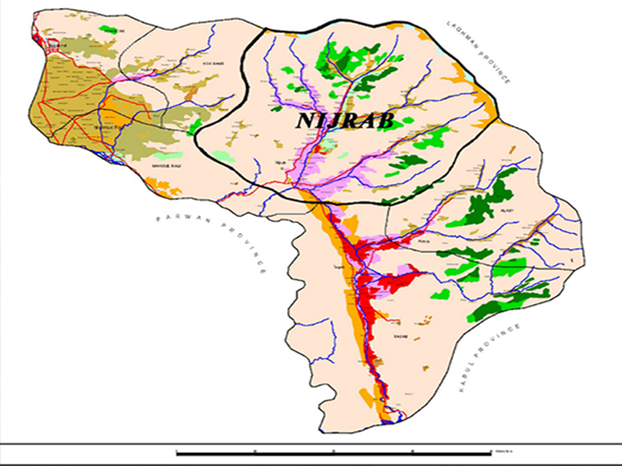Nijrab District
, located in the heart of Kapisa Province, Afghanistan, is steeped in a rich historical legacy that reflects its cultural, military, and spiritual importance throughout the centuries. From its ancient origins in the great kingdom of Kapisa to its resilience during the Anglo-Afghan wars, Nijrab has played a pivotal role in shaping the history of the region.

🏺 Ancient Roots in the Kingdom of Kapisa
Nijrab was once part of the ancient Kapisa Kingdom, a powerful realm mentioned in Greek, Chinese, and Indian sources. Kapisa served as a crucial cultural and trade hub during the Gandhara civilization, flourishing between the 6th century BCE and the 11th century CE. This region was a melting pot of Buddhist, Hindu, and Hellenistic influences.
Archaeological discoveries across Kapisa have unearthed Buddhist stupas, rock inscriptions, and artifacts that point to a time when Nijrab and its neighboring valleys were centers of learning and spirituality. The valley’s strategic position near the Silk Road allowed it to be a waypoint for traders and pilgrims traveling between Central Asia and the Indian subcontinent.
📖 Nijrab in the Baburnama
Nijrab is notably mentioned in the Baburnama, the autobiography of Zahir-ud-din Muhammad Babur, the founder of the Mughal Empire. Babur passed through Kapisa and referenced its scenic valleys, hospitality of its people, and its military importance during his campaigns. Nijrab’s rugged terrain and fertile lands made it a notable area of interest to conquerors and emperors alike.
Babur’s writings illustrate a region of majestic landscapes and strong local clans, some of which are believed to be direct descendants of ancient tribal lineages who defended the region against invaders.
⚔️ Anglo-Afghan Wars and Resistance
During the Anglo-Afghan Wars of the 19th and early 20th centuries, Nijrab’s mountains and valleys served as strongholds of Afghan resistance against British imperial forces. The strategic location and difficult terrain gave local fighters the upper hand in guerrilla warfare.
Many elders and families in Nijrab still recount stories of brave Mujahedeen, tribal leaders, and villagers who fought fiercely to protect their homeland. Oral histories passed down for generations tell of hidden trails used to evade British patrols, and mountain passes used to supply resistance fighters. Nijrab was a place where the spirit of independence and resilience burned bright.
🕌 Spiritual and Cultural Legacy
Nijrab is also known for its deep spiritual traditions, with ancient shrines and Sufi lodges (khanqahs) dotting the valleys. Local folklore speaks of saints and mystics who meditated in its caves and brought knowledge and peace to the people. These sites are still visited by villagers seeking blessings, a testament to the district’s enduring spiritual heritage.
🏞️ A Living History
Today, the people of Nijrab take pride in their cultural identity, historical depth, and ancestral bravery. Efforts are ongoing to preserve ancient manuscripts, oral stories, and archaeological sites, as Nijrab continues to stand as a symbol of heritage and hope in Afghanistan.
Whether through its valleys steeped in legend, its role in empire-building, or its defiance against foreign domination, Nijrab’s story is one of courage, wisdom, and an unbreakable bond to the land.

